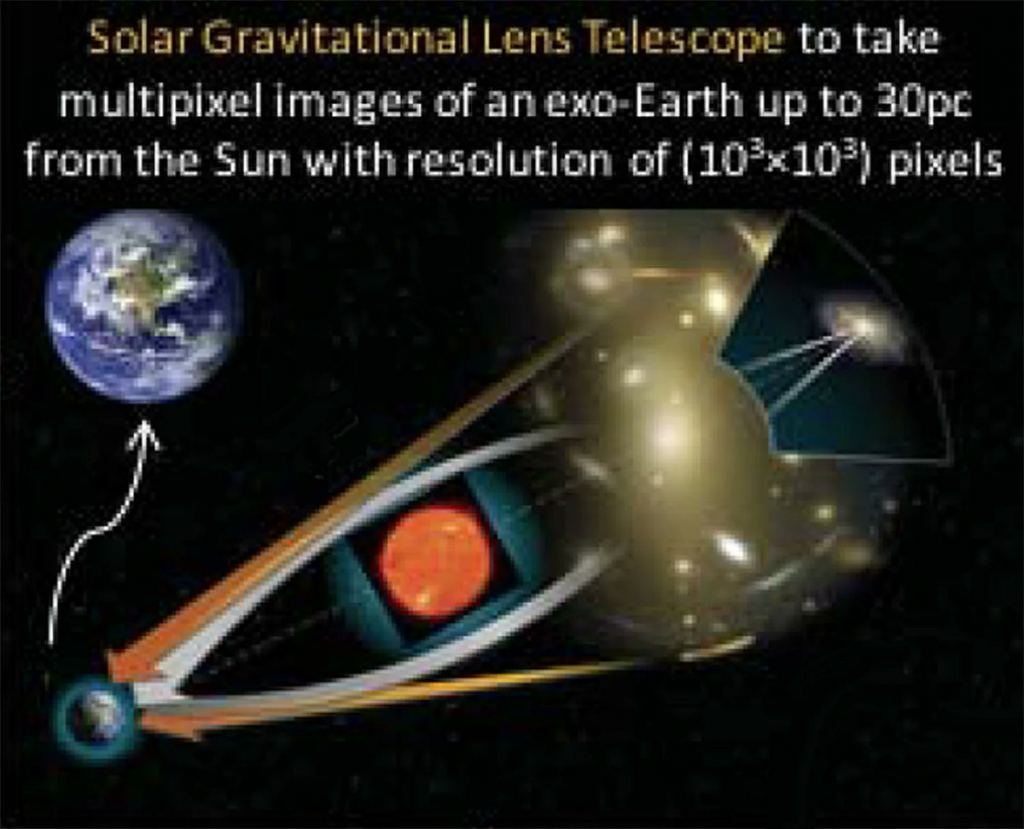NASA’s Institute for Advanced Concepts is famous for supporting outlandish ideas in the astronomy and space exploration fields. Since being re-established in 2011, the institute has supported a wide variety of projects as part of its three-phase program. However, so far, only three projects have gone on to receive Phase III funding.
And one of those just released a white paper describing a mission to get a telescope that could effectively see biosignatures on nearby exoplanets by utilizing the gravitational lens of our own Sun. That Phase III distinction comes with $2 million in funding, which in the case went to JPL, whose scientist, Slava Turyshev, was the principal investigator on the project’s first two phases. He teamed up with The Aerospace corporation for this latest white paper, which describes a mission concept in more detail and defines what technologies already exist and what needs further development.
However, there are several striking features of this mission design, one of which is touched on in detail over at Centauri Dreams . Instead of launching a large craft that would take a long time to travel anywhere, the proposed mission would launch several small cube-sats and then self-assembly on the 25-year journey out the solar gravitational lens (SGL) point. Remove All Ads on Universe Today Join our Patreon for as little as $3! Get the ad-free experience for life That “point” is actually a straight line between whatever star the exoplanet is around and somewhere between 550-1000 AU on the other side of the Sun.
That is a tremendous distance, much further than the measly 156 AU that Voyager 1 has so far taken 44 years to traverse. So how could a spacecraft get to three times the distance while taking almost half the time? Simple – it will dive (almost) into the Sun. Using a gravitational boost from the Sun is a tried and true method.
The fastest human-made object ever, the Parker Solar Probe, used just such a technique. However, being boosted to 25 AU a year, the expected speed at which this mission would have to travel isn’t easy. And it would be even more challenging for a fleet of ships rather than just a single one.
The first problem would be material – solar sails, which are the mission’s preferred method of propulsion, don’t do so well when subjected to the intensity of the Sun that would be required for a gravitational slingshot. In addition, the electronics on the system would have to be much more radiation hardened than currently existing tech. However, both of these known problems have potential solutions under active research.
Another seemingly obvious problem would be how to coordinate a passage of multiple satellites through this sort of gut-wrenching gravitational maneuver and still allow them to coordinate joining up to effectively form a fully functional spacecraft in the end. But according to the paper’s authors, there will be more than enough time on the 25-year journey out to the observational point to actively rejoin the single Cubesats into a cohesive whole. What could result from that cohesive whole is a better image of an exoplanet that humanity is likely to get short of a fully-fledged interstellar mission.
Which exoplanet would be the best candidate would be a topic of hot debate if the mission moves forward, as more than 50 so far have been found in the habitable zones of their stars. But that is certainly no guarantee as yet. The mission hasn’t received any funding nor any indication that it will do so in the near future.
And plenty of technologies would still have to be developed before such a mission would even be feasible. But that is precisely how such missions always start, and this one has more potential impact than most. With luck, at some point in the next few decades, we would receive as crisp of an image of a potentially habitable exoplanet as we are likely to receive in the even medium future.
The team behind this research deserves praise for laying the groundwork for such an idea in the first place. Learn More: Helvajian et al. – A mission architecture to reach and operate at the focal region of the solar gravitational lens Centauri Dreams – Solar Gravitational Lens: Sailcraft and In-Flight Assembly UT – Astronomy Jargon 101: Gravitational Lens Stanford – Scientists describe a gravity telescope that could image exoplanets Lead Image: Depiction of the system from the Phase I NIAC report.
Credit – Slava Turyshev.
From: universetoday
URL: https://www.universetoday.com/156856/a-mission-to-reach-the-solar-gravitational-lens-in-30-years/



